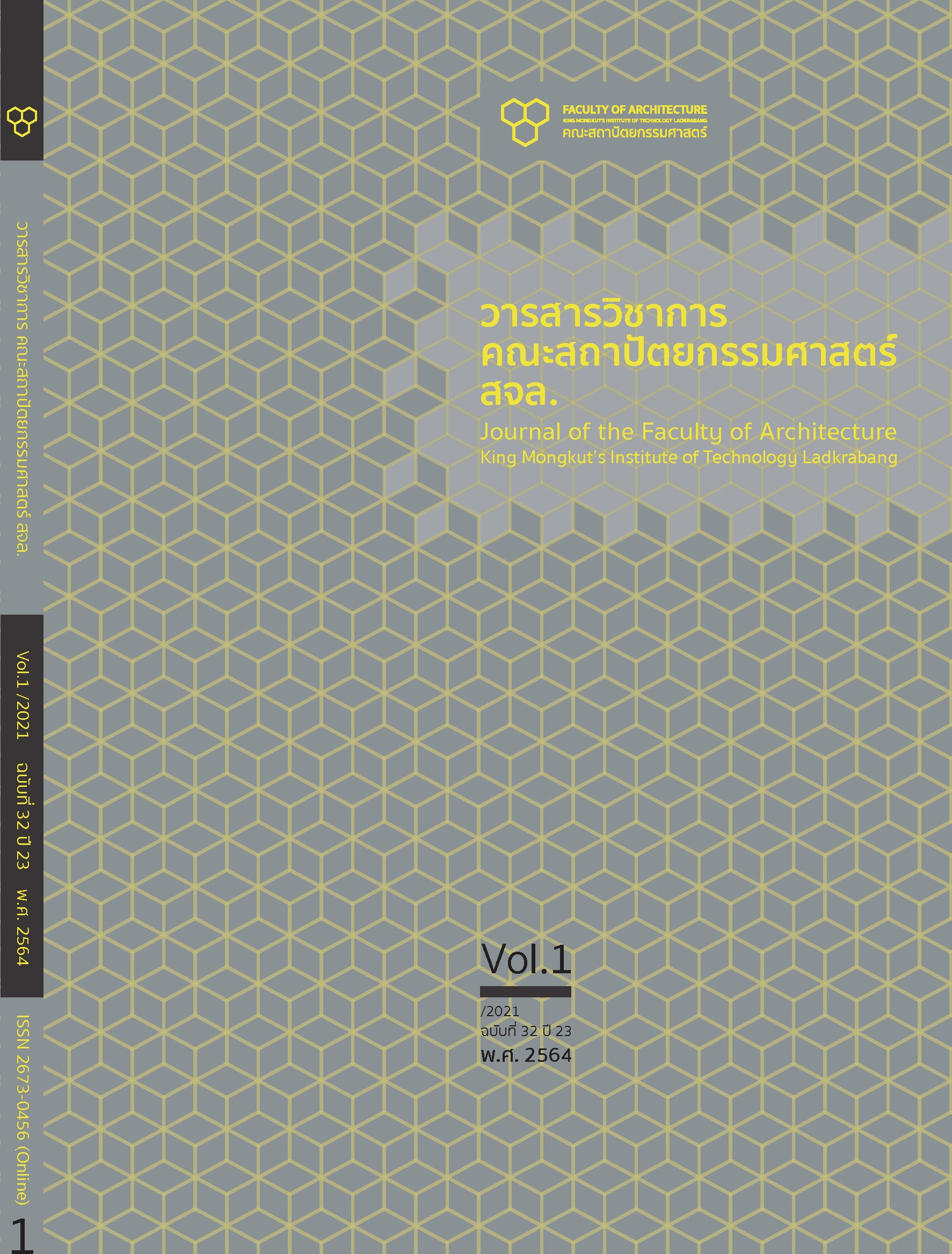Specifying Expected Learning Outcomes for Bachelor of Fine and Applied Art Program in 3D-Based Communication Design and Integrated Media through Delphi Method
Main Article Content
Abstract
Identifying the expected learning outcomes is a significant starting point for outcome-based education. Bachelor of Fine and applied art program in 3D-based communication design and integrated media, faculty of architecture, King Mongkut’s institute of technology Ladkrabang had considered the principle of outcome-based education in designing the curriculum, and planning the teaching and learning activities since 2016. The research objective is to specify the expected learning outcomes for the program revision in 2021 through Delphi method by gathering, analyzing, and synthesizing data from stakeholders into consensus that meet the requirements of the professional field in the job market. The data was gathered from 23 experts in 3D-based communication design and integrated media, and extracted into 31 factors of competency. Item-level content validity index (I-CVI) and modified Kappa statistic was performed to evaluate each factor validity and reliability. From the findings, 29 factors have excellent degree of validity and reliability, and the scale-level validity index of 0.927 indicates that the extracted factors are acceptable for specifying the program’s expected learning outcomes. The results from clustering extracted factors are 7 domains of expected learning outcomes those are (1) design principles and foundations, (2) creativity and design strategy, (3) design research, (4) content and storytelling through media, (5) design implementation, (6) design presentation and communication skills, and (7) design quality.
Article Details
This work is licensed under a Creative Commons Attribution-NonCommercial-ShareAlike 4.0 International License.
Copyright Transfer Statement
The copyright of this article is transferred to Journal of The Faculty of Architecture King Mongkut's Institute of Technology Ladkrabang with effect if and when the article is accepted for publication. The copyright transfer covers the exclusive right to reproduce and distribute the article, including reprints, translations, photographic reproductions, electronic form (offline, online) or any other reproductions of similar nature.
The author warrants that this contribution is original and that he/she has full power to make this grant. The author signs for and accepts responsibility for releasing this material on behalf of any and all co-authors.
References
ธานินทร์ ศิลป์จารุ. (2563). การวิจัยและวิเคราะห์ข้อมูลทางสถิติด้วย SPSS และ AMOS. พิมพ์ครั้งที่ 18. กรุงเทพมหานคร: ห้างหุ้นส่วนสามัญบิสซิเนสอาร์แอนด์ดี.
ประไพพิมพ์ สุธีวสินนนท์ และประสพชัย พสุนนท์. (2559). กลยุทธ์การเลือกตัวอย่างสำหรับการวิจัยเชิงคุณภาพ. วารสารปาริชาต มหาวิทยาลัยทักษิณ. 29(2), 31-48.
American Institute of Graphic Arts. (2018). AIGA designer 2025: Why Design Education Should Pay Attention to Trends. Retrieved from: https://educators.aiga.org/wp-content/uploads/2017/08/DESIGNER-2025-SUMMARY.pdf.
An, I. L. (2014). Impact of Outcome-Based Education iIstruction to Accountancy Students in an Asian University. Asia Pacific Journal of Education, Arts and Sciences. 1(5), 48-52.
Anderson, L., & Krathwohl, D. R. (2001). A Taxonomy for Learning, Teaching and Assessing: A Revision of Bloom's Taxonomy of Educational Objectives. New York: Longman.
Dede, C. (2010). Comparing Frameworks for 21st Century Skills. In. J. Bellanca & R. Brandt (Eds.), 21st Century Skills: Rethinking How Students Learn. Bloomington, I.N.: Solution Tree Press.
Dettmer, P. (2005). New Blooms in Established Fields: Four Domains of Learning and Doing. Roeper Review. 28(2), 70-78.
Donohoe, H. M., & Needham, R. D. (2009). Moving Best Practice forward: Delphi Characteristics, Advantages, Potential, Problems, and Solutions. International Journal of Tourism Research. 11, 415-437.
Harden, R. M. (2002). Developments in Outcome-Based Education. Medical Teacher. 24(2), 117–120.
Kaliannan, M., & Chandran, S. D. (2012). Empowering Students through Outcome-Based Education (OBE). Research in Education. 87(1), 50-63.
Krathwohl, D. R., Bloom, B. S., & Masia, B. B. (1964). Taxonomy of Educational Objectives: The Classification of Educational Goals. Handbook II: Affective Domain. New York: David McKay.
Lynn, M. R. (1986). Determination and Quantification of Content Validity. Nursing Research. 35, 382–385.
Macmillan, T. T. (1971). The Delphi Technique. The Annual Meeting of The California Junior Colleges Associations Committee on Research and Development. 1-24.
Morcke, A. M., Dornan, T., & Eika, B. (2013). Outcome (Competency) Based Education: an Exploration of Its Origins, Theoretical Basis, and Empirical Evidence. Advances in Health Sciences Education. 18, 851–863.
Oreta, A. W. C., & Roxas, C. L. C. (2012). Implementing an Outcomes-Based Education Framework in the Teaching of Engineering Mechanics (Statics). International Conference on Civil Engineering Education (ICCEE2012). 1-15.
Polit, D. F., Beck, C. T., & Owen S. V. (2007). Is the CVI an Acceptable Indicator of Content Validity?: Appraisal and Recommendations. Research in Nursing & Health. 30, 459-467.
Rovai, A. P., Wighting, M. J., Baker, J. D., & Grooms, L. D. (2009). Development of an Instrument to Measure Perceived Cognitive, Affective, and Psychomotor Learning in Traditional and Virtual Classroom Higher Education Settings. Internet and Higher Education. 12, 7-13.
Simpson, E. J. (1972). The Classification of Educational Objectives in the Psychomotor Domain.Washington, D.C.: Gryphon House.
Tigelaar, D. E. H., Dolmans, D. H. J. M., Wolfhagen, I. H. A. P., & Van Der Vleuten, C. P. M. (2004). The Development and Validation of a Framework for Teaching Competencies in Higher Education. Higher Education. 48, 253-268.

